The Covid-19 lockdown brought lots of changes for me. I have spent two years working from home and my two sons have both reached the age to start driving. We became a two car family with four drivers. While school was done remotely and our outdoor activities moved to zoom calls, this wasn’t a problem. But as things started to open up, there started to be an issue. My wife needed her mini-van to do errands and go to meetings and the boys started to use the Prius to go to school and bring them home after track practice.
As a telecommuter, I had the least need for a car. That meant that I no longer had a car that was mine full-time and that I had to schedule in advance when I needed the car for a doctors appointment, hair cut, or other errand. I had had a car that was for my primary use for almost 40 years and no longer did. I started to get feelings of being trapped. This was understandable but also semi-irrational since I didn’t really have anywhere to go. Once I recognized the feeling and the cause it improved significantly.
Still, my job was encouraging people to return to the office at least some of the time and more activities were opening up that I wanted to be able to go to, so we needed to add another vehicle. Due to the ages of our current cars (2007 Prius and 2015 Honda Odyssey) it made sense for the new car to become my new primary car.
My other Ioniq 5 articles may also be of interest
- My First Multi-State EV Roadtrip
- Ioniq 5 Frequently Asked Questions Answered
- Two Years with my Ioniq 5 EV
Article Table of Contents
- Making a List
- Checking it Twice
- Narrowing it Down
- Making the Decision
- Getting Ready
- The New Car with lots of pictures
- Post-purchase Work
- Shopping List
- Vehicle and Fuel Costs
- Thoughts on Convenience
Making a List
So, as readers of this blog are probably aware, I am an engineer. That means that I pulled out Excel and started a spreadsheet. I wanted to consider only cars that were electrified (hybrids, plug-in hybrids, or full battery electric cars.) Luxury car brands were not considered.
My list ended up with 3 cars from Tesla, 7 from Toyota, 8 from Hyundai, 4 from Honda, 1 Chevy, 1 VW, and 4 from Ford. Since I was working with a spreadsheet I attempted to capture the lifetime costs of ownership of each car including initial purchase price, tax rebates and fuel costs. I did not include taxes, insurance, or maintenance. Then I could play with my assumptions and see how the cost numbers changed if I changed input values like the price of gas, price of electricity, lifetime mileage, etc. I’m not going to share the spreadsheet as the prices change rapidly and some of my assumptions make sense for me but aren’t necessarily generally true, but if a friend wants to use it as a starting point please ask.
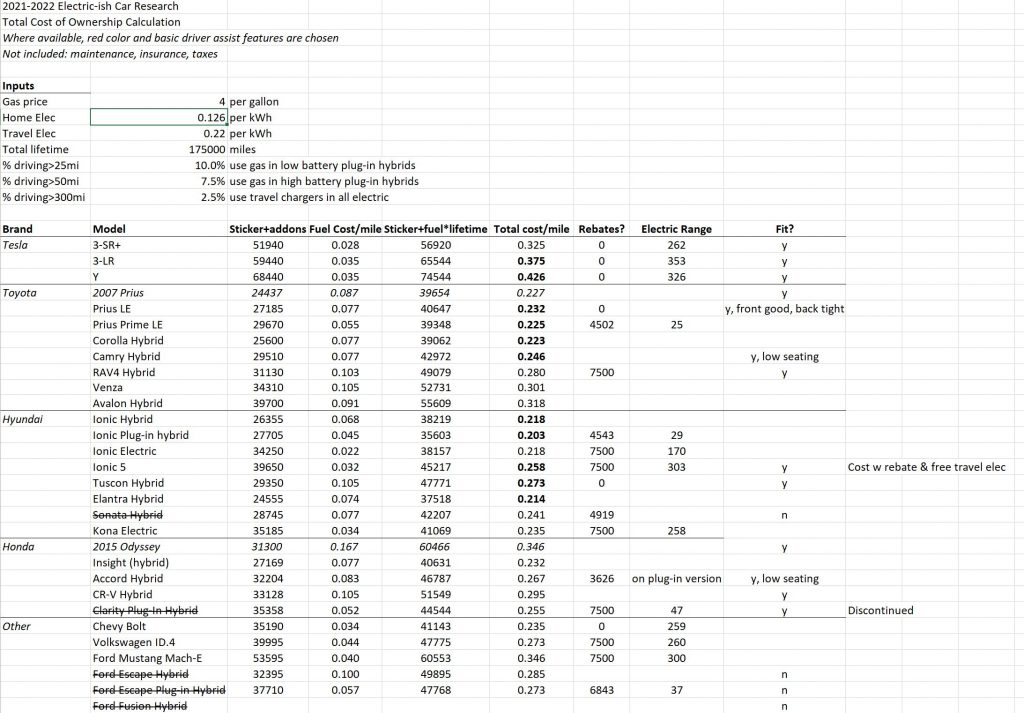
Checking it Twice
The next step was to start seeing the cars in person and seeing it I fit. From previous car purchase cycles I knew that sometimes my head will rub against the roof, there wouldn’t be enough leg room, or the cockpit of a car will just feel wrong to me with no place to rest my elbows. My wife and I scheduled one slightly extended lunchtime each week to go visit a different dealership and sit in as many of their electrified models as we could.
This strategy wasn’t as effective as we would have liked. Chip shortages, global shipping issues, and a backlog of demand meant that there were very few cars on dealers’ lots. If we could sit in cars at all we would frequently have to sit in the gasoline version of the car rather than the hybrid or electric variant. These were similar enough from a driver-fit perspective that we were able to eliminate several options as not comfortable for us.
So we expanded our search area to find cars to look at. Our first stop was a large used-car dealership. We were able to fit-check several more of the cars on my list. Then we reached out to friends. We were able to sit in a test drive a Tesla Model Y this way. But, there were several strong candidates (Ford Mustang Mach-E, I’m looking at you) that we never got to see in person.
As additional sources of data, I did a lot of online research. I watched lots of review videos on YouTube. Alex on Auto‘s channel was extremely helpful. Out of Spec Reviews and GJeebs were also favorites. I joined owners groups on Facebook and Reddit for some of the serious candidates to get a feel for common problems with the cars and how helpful the owners communities were. Another excellent (but hour-long) video on how electric cars and charging work is available here.
Narrowing it down
Overall, seven months passed between the start of my research and my eventual purchase. Prices, particularly on the Teslas, changed. Cars were discontinued or were so rare that they might as well have been. Many cars had waiting lists that were six months or more long. And many car dealers were taking advantage of the shortages and charging significant markups above MSRP. The old days of buying a car for less than MSRP were long gone.
I initially thought that I would buy a plug-in hybrid so that I would have electric-car fuel savings for my day to day use and gas range for when I wanted to go on a trip. I considered the Honda Clarity and the Toyota Prius Prime. But, over time, I watched multiple videos of people taking cross-country trips in their EVs with very little problem. Yes, a little more planning effort was needed but it was not at all overwhelming. And it looked like it would become easy after a couple of trips to learn how things work.
One criteria that I had for the new car was that I wanted to be able to make a round trip to a nearby major city without refueling. Each way was about 70 miles, so I had a minimum 150 mile range requirement. Only one of the cars that I considered had a low enough range (170 miles) that this could be an issue.
A month before my purchase, the Hyundai Ioniq 5 electric SUV started to get a lot of positive press. I called around my local area and checked for stock on Hyundai’s website. Neither of my two close dealerships were equipped to sell electric cars, but one 40 minutes out had 11 of the cars in stock. I made an appointment for a test drive. Both my wife and I fit comfortably in the car, there was plenty of room in the back seats for two 6-foot-plus teen aged boys and I liked the layout of the controls. The test drive went well. The car also qualified for a $7500 federal tax credit (which will apply when we file 2022 taxes in early 2023).
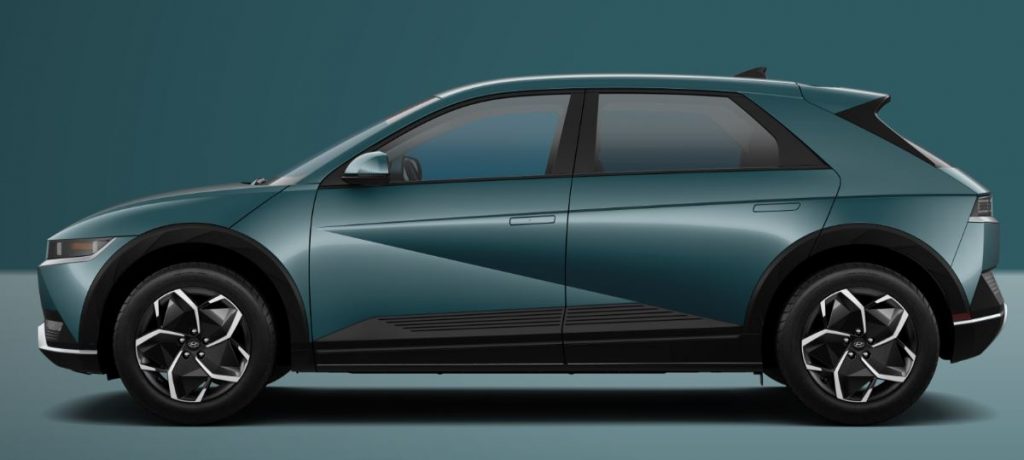
We thanked the salesman, told him that we were targeting a mid-to-late summer purchase time and hadn’t 100% made peace with having a fully electric car and headed home. We continued the research and attempted to sit in/test drive a Ford Mustang Mach-E that a local dealership showed as in-stock. I hadn’t called ahead and the car was no longer on the lot. They took our information and promised to call us when we could come see one; I haven’t heard back from them.
Making the Decision
Over the next couple of weeks I watched stock ebb and flow on dealer websites, read stories and watched videos about huge dealer markups and long waits. One video that made an impact was a gentleman from Texas who flew to Green Bay, WI to get the EV he wanted at MSRP who then drove it back home to Texas. The trip costs were significantly less than the markups close to him. Tesla and Ford continued to have six month or longer waiting on orders.
It was the uncertainty of what, if anything, would be available for purchase in mid-summer that made us get off the fence and make a decision. The 40-mile away Hyundai dealership was continuing to get a slow trickle of stock and was not marking up over MSRP. I had originally wanted the middle “SEL” trim level, but at that point they only had the base “SE” and the top “Limited” versions. I rechecked the differences, decided that none of them were very important to me and settled on an “SE”. They had a few of that trim in the color that I wanted listed. All of the cars were the AWD version, which was what I wanted due to the heat pump, added performance, and infrequent use in snow. The AWD option does cut the estimated range of the car from 303 to 256 miles, but that is well over my 150 mile minimum range that I wanted for the car.
I gave the dealership a call. Only one of the cars was not sold. It was an SE with the colors I wanted. So, I put down a deposit. They gave me a contract for the agreed price, a VIN for the exact car I had reserved, and an expected delivery date that was two weeks away (the car was in transit to the dealership). The MSRP for the car was $49k before the $7500 tax credit that I’ll get in almost a year. Sales tax, tags, and title bumped up that total another couple of thousand. Virginia adds an EV tax on the vehicle registration to replace the lost road-maintenance money from gas taxes. It is around $110 per year.
Getting Ready
Before my wife would agree to the purchase, she very reasonably wanted to understand the secondary costs. I wanted to install a home, level 2, “charger” (more properly an EVSE, since the actual charger is in the car, but…). My local Model Y owning friends don’t have a home charger and have to make a trip to the local mall to use a supercharger station when they want to fill up. I didn’t want to have to do a similar chore and had seen estimates of installation costs running between $3k and $12k.
I looked up a highly rated electrical company in my area and arranged for them to come out and give me a quote. Our electrical panel is in the back of our garage and the garage is too small to actually park anything but the smallest car in, so we needed a 240V line run to the front of the garage to install the charger near where the car could park. We decided that the wall space between the two garage doors would allow flexibility of location of the car being charged. The installation quote came to under $1700 plus the cost of the EVSE that I would purchase online.
One of the major advantages of the Ioniq 5 is the speed at which it can charge. On trips, in good conditions, it can charge at around 250kw allowing it to go from 10 to 80 percent charge in 18 minutes (cold weather and other factors can sometimes double that time). At home it can charge at up to 11kw on a 240V line with a 60A breaker drawing 48A. To achieve that, the charger needs to be hardwired rather than plugged into a dryer style outlet. At that 11kw power it can charge the battery from 0 to 100 percent in 6.7 hours. The included 120V charger would take almost 54 hours to do the same. I don’t expect to ever need to go from 0 to 100, but I do want to be able to do a normal “fill-up” overnight or get the most from a slight top off after work before heading out on an evening expedition.
My local electric company, Dominion Power, has an EV charging rewards program. If you use one of the listed EVSE devices and agree to let them request that you do not charge during very high demand times, they’ll give you an annual $40 reward. I used their list of qualifying devices as a starting point and chose one that had good reviews (see this video – his channel is great for EVSEs) and that supported the 11kw charging speed that I wanted. The ChargePoint Home Flex at $699 was on the pricey end of the devices, but met my requirements. I can even control and monitor the charger from my phone or via my Amazon Echo/Alexa devices.

I have used the charger once so far, at a slower 9.3kw due to a setting issue that has been fixed. I added 139 miles of range in 4.3 hours at a cost of $4. A very brief second charging session confirmed that after the change my hardwired EVSE was delivering 11kw.

Compared to any hybrid or pure gas car that is a substantial fuel savings!
The car also included two years of free unlimited 30-minute DC charging at Electrify America stations. These are fairly common around my part of the country but the closest one is 15-20 minutes away from my house. So, I’ll do a test fill when I next need a charge but will generally use them only while traveling.
The New Car
The electrician needed a day and a half to do the EVSE install as well as several other home electrical tasks that we had saved up. Amazon delivered the charger in the middle of the first day. Later that day we also got a call from the dealership that the car had been delivered and that we could pick it up the next day. This was more than a week early!
We headed off across the bottleneck of the Hampton Roads Bridge Tunnel to arrive at the dealership at a little after 3pm. The paperwork, app setup, and car walkaround/briefing took about 2 hours. So, the first drive in my new car was in rush hour traffic across a notorious slow point. No pressure.
My wife and I had driven down in the minivan together and she followed me home. After we got here she asked if the new car had a speedometer. The car was so powerful and so quiet that I couldn’t feel how fast I was going other than relative to the other traffic. That’s something I need to do better at before a police officer makes a similar, but more expensive, comment to me.
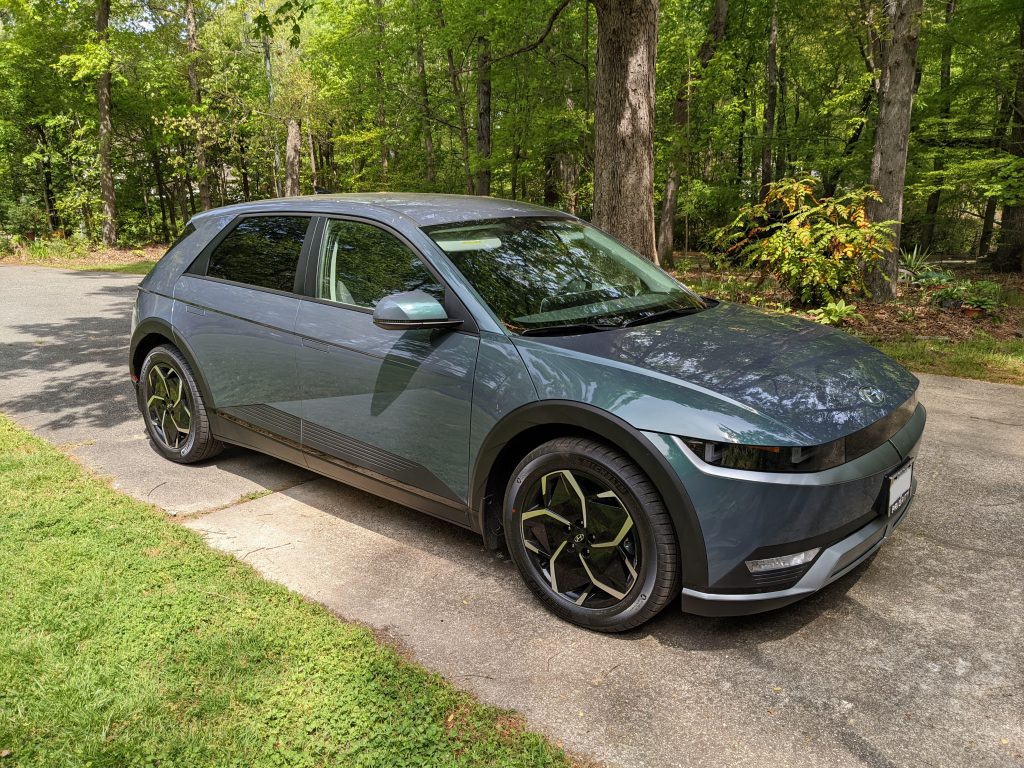
The paint color is called “digital teal”. Depending on the lighting it can look grey, blue, or green.
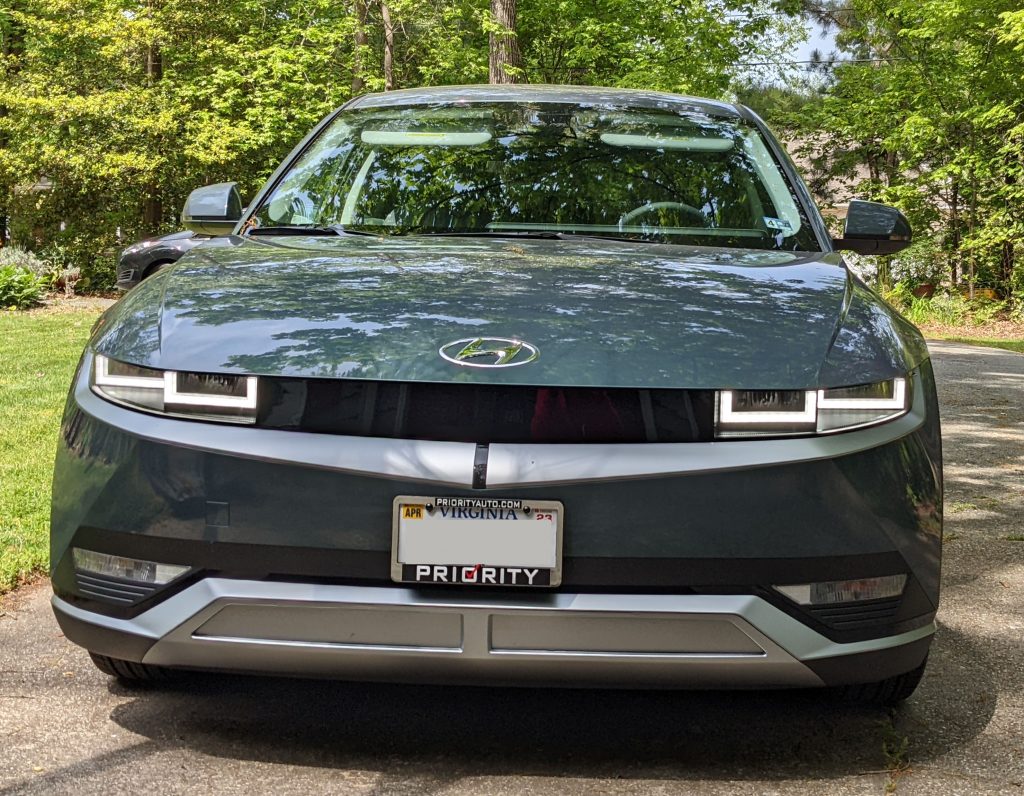
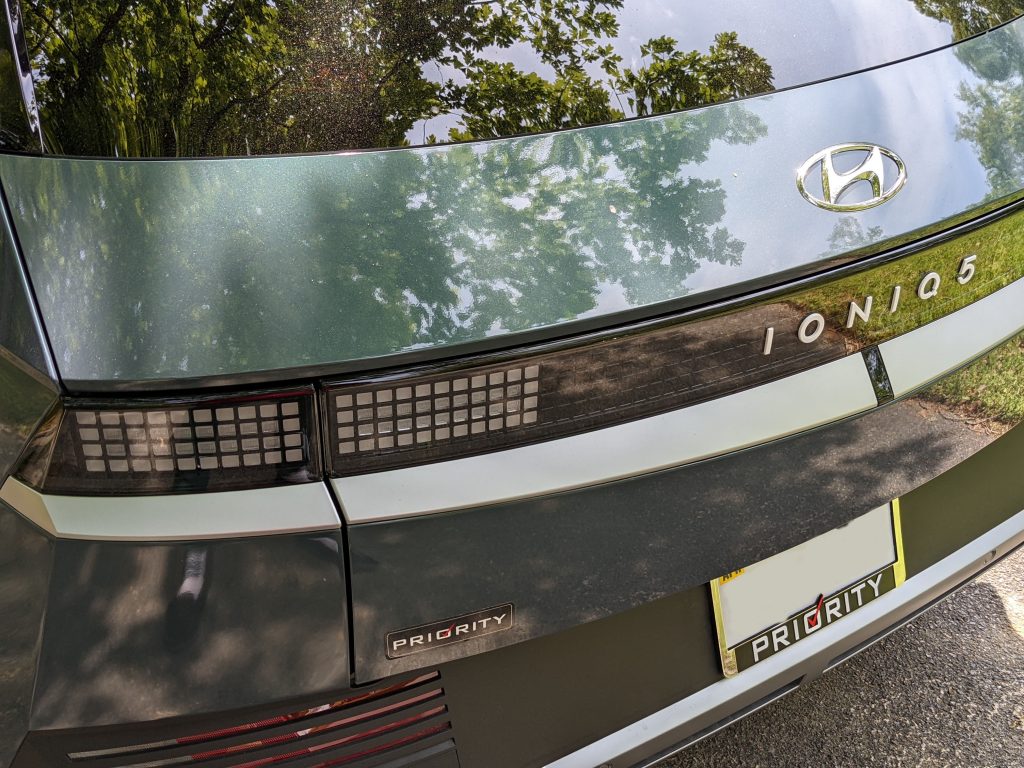

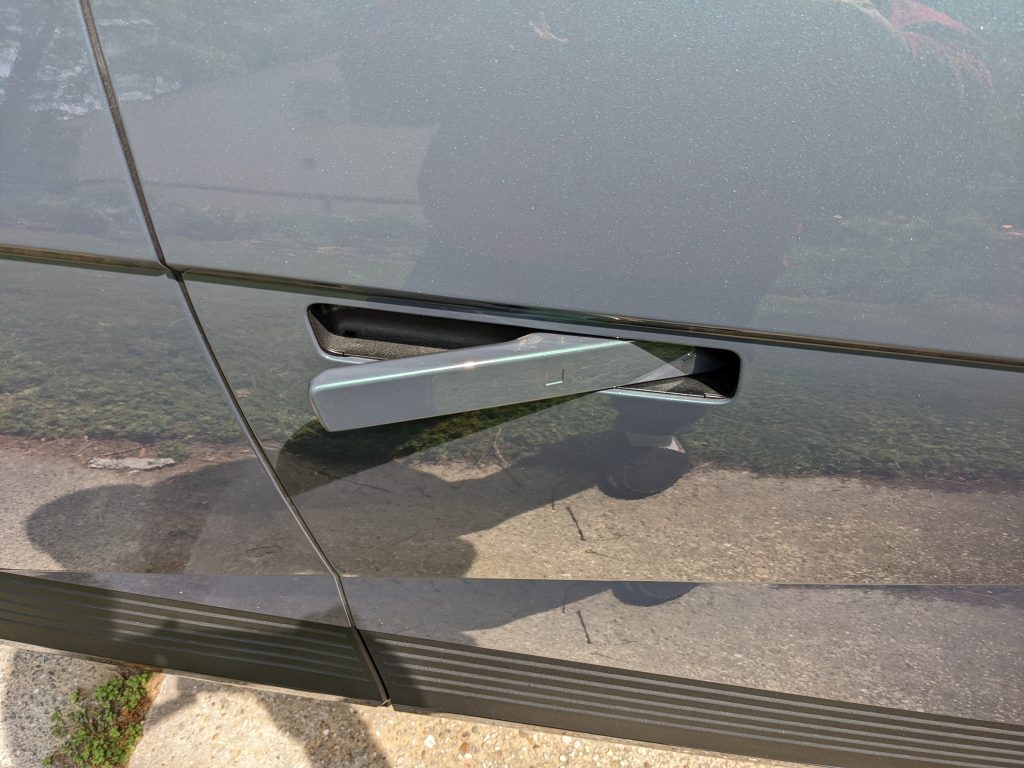
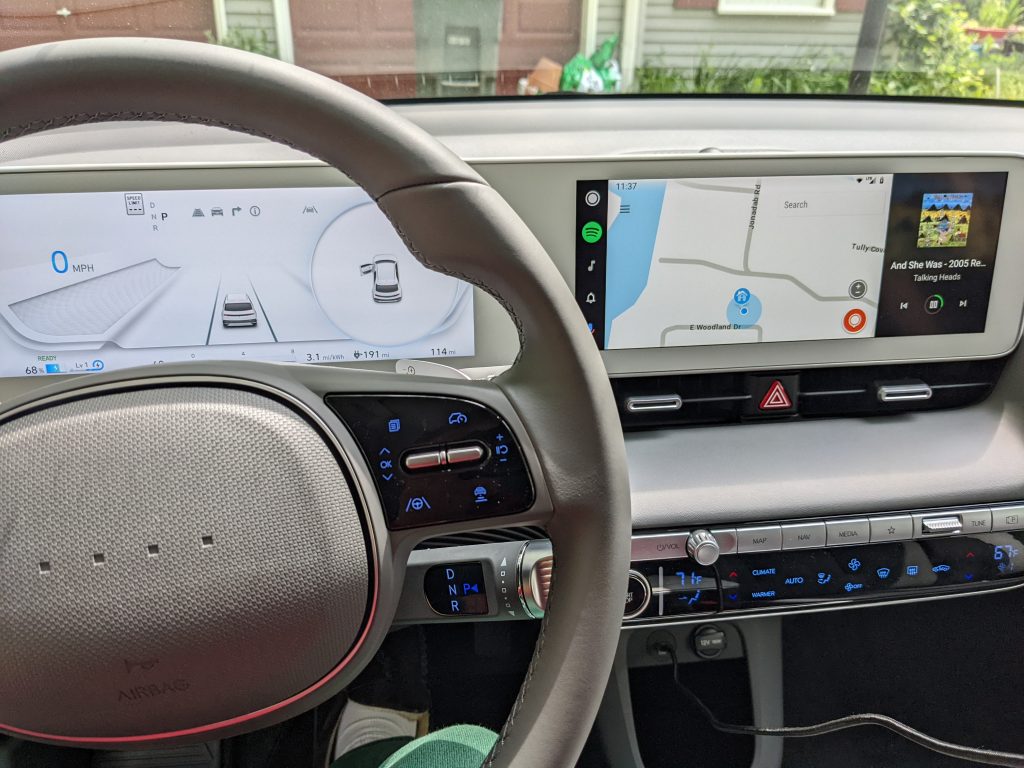
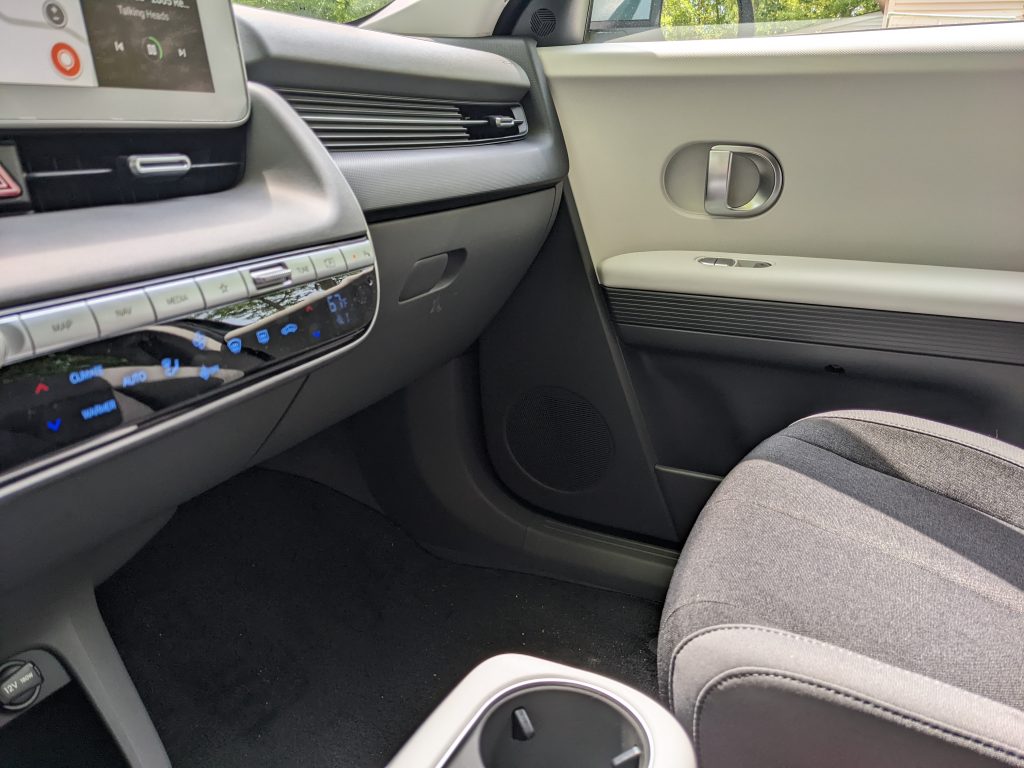
I have a few more pictures in a shared google album here.
Post purchase work
During stops in traffic on the ride home, I fiddled with a few of the settings and couldn’t get a few things exactly set the way I wanted. That night I made a to-do list of things to research or otherwise address. In a stroke of luck, an update was released for the infotainment screen the next day that addressed those settings directly. It was a 34 gigabyte download that took about 2 hours total to download to my PC, copy to a 64gb USB stick and then install in the car. Not fast, but now the Android Auto split-screen showed both my map and the current Spotify song and both LCD screens could be set to automatically switch to dark mode at night.
Some small items that I purchased for the car (most product links are affiliate links):
- usb cables
- snow/ice scraper
- tire pressure gauge
- ceramic spray and micro fiber cloths for improving rear window rain performance (see this video and this video)
- Small window squeegee with squirt bottle for cleaning windows when not at a gas station.
- front wiper blades (driver, passenger) due to owner suggestions but I haven’t been unhappy enough with the stock ones to install them.
- “TeslaTap” adapter that allows me to use level 2 chargers with Tesla plugs but not the high speed superchargers or this Lectron model is one of many alternatives (read the reviews!).
- usb car battery jumper kit mostly to help other people but also to rescue myself in the unlikely event of running down my 12v battery. Protip: store it in the frunk, not the trunk, for much easier access since you can’t open the trunk with the 12v dead.
- key fob cover
- LED replacement bulbs for trunk and map lights (see this video).
- small trash cans with lids that fit in the bottle spot on the doors. My wife was not a fan of these.
- small metal trays (or smaller version) to reduce debris from eating in the car (which I expect I will do a little more while waiting on a charge)
- magnet with my college logo
- magnetic glasses holder for the fabric covered steel plate on the driver’s dash
- strong round magnets to hold my phone (or rectangular version)
- steel plate to put inside my plastic phone case
- binder/portfolio to keep my registration, inspection, and insurance cards easy to find
- wireless Android Auto adaptor
- tempered glass screen protectors for instruments and infotainment screens
- upholstery cleaning brush
- for completeness, the EVSE I bought: Charge Point Home Flex
- 120V socket to pull power out of car: Hyundai V2L adaptor, or 3rd party (Lectron) model
There were also some interesting choices that I looked at but did not purchase
- Cargo area cover
- Arm rest storage trays: upper and lower
- Hyundai Morse code (4 dots) hood and hatch badge replacements
- Mats for Tray, cup holder, arm rest, etc. areas


I also printed a proof-of-insurance card, checked in with my county office on property taxes and read up on the driver assist modes, buttons, and display icons that had confused me on the drive home. And I’ve visited the DMV to swap my NASA vanity plates onto the new car.
Vehicle & Fuel Costs
One of the frequent questions I’ve been asked is how much it costs to operate the car. So, I’ve been keeping a spreadsheet log of all of my electric charging. I’ve been amazed at how little it has cost to drive!
First, here is a list of all the up-front costs including the car, taxes, registration, purchase and installation of the level 2 charger/EVSE, and the federal tax credits for the car and for the EVSE purchase/install.
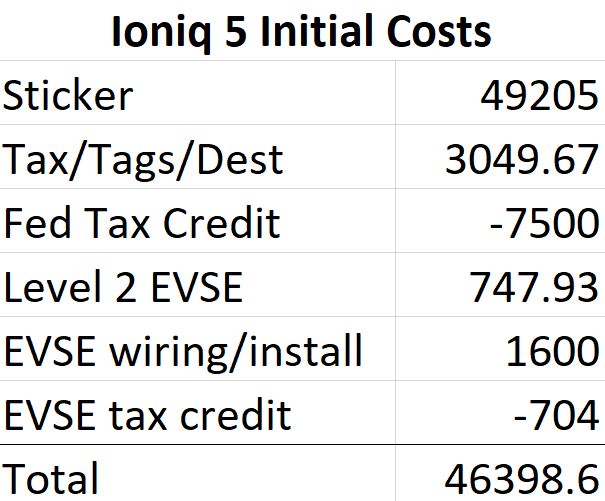
Compared to the other cars on my initial list, this total is on the low end for the full electric vehicles but higher than the hybrid and plug-in hybrid models. I knew that going in and tried to estimate the difference in fuel costs over the lifetime of the car to see if they would offset the initial purchase price difference. My estimate showed the total cost equalizing over the car’s lifetime assuming gas was $3.50. Months later when I actually purchased the car, gas is almost a dollar higher, so the point of equal total cost should occur earlier.
But, how good was my estimate of electric charging costs? I have been tracking my exact costs for every charge that I have made on the new car. At home my electricity costs 11.66 cents per kWh. A Google search estimates the US national average cost at 13.82 cents/kWh. The Ioniq 5 also comes with 2 years of free 30 minute charging sessions at Electrify America (EA)’s DC fast charging stations. Since that was included as part of my purchase, I have been using this perk whenever I am otherwise near a charger (i.e. not making a trip just to charge). And also I’ve made a couple of full overnight charges at home using the slower level 2 charger.
My longest home charge took 6.5 hours to go from 9 to 100% battery charge, adding 72.93kWh for a cost of $8.50. That cost is almost exactly the same as 2 gallons of gas but I got an estimated 250 miles of range out of it.
Here is the summary of the most recent data from my charge tracking spreadsheet.

Currently, I have spent $13.17 to go 922 miles or 1.4 cents per mile. A 50mpg hybrid would have cost 6 times as much at $4.25 per gallon (or 8.5 cents per mile), a 25mpg sedan would have cost 8.4 times as much at 12 cents per mile and a 12mpg truck would have cost 24.8 times as much at 35.4 cents per mile. Another way to look at these numbers is that I am paying the same for fuel that I would be if I had a gas car that had 300mpg efficiency. It will take a while, but the fuel cost differences will definitely eventually offset the difference in initial purchase costs.
When I posted these results elsewhere online, I got some pushback about including my free EA fast charging. My feeling is that they were included in the price of the car and were one reason for my selection of this car. If I had paid for those charges they would have cost 43 cents per kWh and about $54 total, which is still less than the equivalent gas costs. I haven’t yet gone on a trip where I actually needed the fast charging; I have done these to learn the process and to get the free electrons that were included with my car. I would not have unnecessarily paid the higher rate. When my two years of free charging is over, I will do more of my charging at home and shift to only using higher speed DC fast charging while on a trip. Note that fast charging rates vary across the country with some states requiring charging by the minute rather than by kWh. Those by-the-minute charging sessions should be great deals for fast charging cars like the Ioniq 5.
Update 1: I just took my first road trip where I had to stop and charge in order to reach my destination. The round trip was a total of 425 miles. I had to stop twice – both times at the same station, once on the way out and once on the return. I was able to get the necessary charge boosts as calculated by the “A Better Route Planner” site and phone app in less time than it took me to use the restroom and order food. So, I didn’t have any waiting-around-to-charge-time on the trip at all. I also stopped at the EA charging station near my house when I returned since I was driving by it and could get a free fast charge to mostly fill my battery back up. I have now driven the car about 2000 miles with an out of pocket fuel cost of under $20, or down to 1 cent per mile. With gas currently at $5 per gallon that is a tenth of what fuel would have cost for a 50mpg Prius.
Update 2: I have now driven about 3500 miles in four months for an out-of-pocket cost of $34.31 – which maintains the penny per mile cost. If I had paid for the fast DC charging at Electrify America, my cost would be $304.35 or a little under 10 cents per mile. Once the free charging period expires, I will shift to charging at home most of the time and using the fast chargers only on road trips. So, I expect my long term energy costs will be on the lower end of the one to ten cents per mile range.
Update 3: See my separate post on my first multi-state road trip – a 1600 mile odyssey from Virginia to Michigan and back.
Update 4: I recently passed 10000 miles on the car and am closing in on a year of ownership. I have now paid $189.24 for fuel for 10512 miles, or 1.8 cents per mile. If I had paid for the $686.59 in free Electrify America charging my fuel cost would have been 8.3 cents per mile. I have stopped using the local EA station after realizing that my “free” charging where I bought lunch or at least a candy bar and a soda was costing me more than charging at home. I still use EA on trips as fast charging is the only practical way to road trip in an electric car.
Update 5: See this article, Two Years with my Ioniq 5 EV, for my costs at 2 years/20000 miles of ownership.
There are other differences in the cost of ownership. Electric cars are less expensive in regards to normal maintenance. They don’t need oil changes, for instance. They do eventually need new tires, wiper blades, and brake pads. To offset the lost of road maintenance income from gas taxes, I pay an annual $109 EV tax* with my car registration. Local property tax is a function of car value, so is higher for a more expensive car. But my insurance cost for the new car is about the same as for our 7 year old mini-van due to the included safety features.
*Virginia has an optional “Mileage Choice” program where an EV owner can opt-in to paying a per-mile road tax that will probably be lower than, but never more than, the flat annual fee. It is a little more complicated to set up and use than just paying the flat fee, but is not all that bad. One nice thing is that you pay in $10 increments throughout the year as you accumulate miles rather than paying the full amount up front. There are a couple of methods for collecting your car’s mileage including an OBDII device. In my case, I gave them authorization to access my Hyundai Bluelink account that monitors my car’s status. I like to pay for my car registration for the maximum 3 years at a time, so this will spread that $327 (or less) across those three years.
Thoughts on Convenience
I have been driving a gasoline powered car for more than 35 years. The cycle of stopping and filling up on gas has long been a regular part of my week. Charging an electric car is just different. In some ways it is easier and some ways it is harder.
Plugging the car in at home is trivial. With my 15 mile round trip to work and continuing to work from home some days, I need to charge less than once a week. I can plug it in at night and have a full (or I set it to stop at 80% full most times) battery in the morning. My charger is hardwired to a 60A breaker, drawing 48A at 240V, delivering about 11kW. Given a 77kWh battery, a full charge from 0 to 100 would take about 7 hours. I don’t expect to ever do a 0 to 100 charge so any real world case will be less than that.
Obviously, a multi-hour charge is a show-stopper on a road trip. For this type of driving there are commercial “DC fast” chargers stationed at convenient increments along all major US interstates. Zoom around the map at https://www.plugshare.com to see public chargers or play at planning a typical family trip at https://abetterrouteplanner.com . DC fast chargers charge much, much faster than my home charger. One of the big selling points of the Ioniq 5 is the speed that it can charge at these stations – it can go from 10 to 80% charge in 18 minutes. That 10-80% charge adds about 200 miles or 3 hours of interstate driving. This is about perfect timing for stretching my legs, visiting the restroom and purchasing a snack – things that I would do just the same if I were road tripping in a gas car. I do expect to spend a little more time refueling than in that gas car, but the difference won’t be huge. A plus for the EV is that I don’t have to stay with the car while fueling as I do with a gas vehicle.
My other Ioniq 5 articles may also be of interest
- My First Multi-State EV Roadtrip
- Ioniq 5 Frequently Asked Questions Answered
- Two Years with my Ioniq 5 EV
